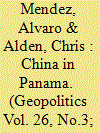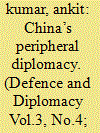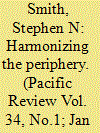| Srl | Item |
| 1 |
ID:
178064


|
|
|
|
|
| Summary/Abstract |
The globalisation of China’s development strategy, from its origins as infrastructure diplomacy connecting its domestic west with its Central Asian periphery, into the transnational Belt and Road Initiative encompassing the periphery of the world system, epitomises the rapid evolution of a Chinese grand strategy of great economic and political ambition. The small state of Panama is a key node in the global trading system that can make an unexpectedly large contribution to China’s national security and international influence. Accordingly, China’s economic statecraft in Panama is not only opening up the Latin America and Caribbean markets to further Chinese commercial penetration, but is simultaneously expanding its political influence in this remotest part of the global South. China’s is a two-track grand strategy positing to other nations a choice between a liberal internationalist co-prosperity and a zero-sum realist contest. This audacious approach relies on relational power amongst small states, especially semi-peripheral ones like Panama, to put China at the forefront of what is shaping up as a grand coalition of the global South collectively challenging American hegemony.
|
|
|
|
|
|
|
|
|
|
|
|
|
|
|
|
| 2 |
ID:
135529


|
|
|
|
|
| Summary/Abstract |
The foreign of a country start from the confines of its geographical boundary, but its initial impact is most visible in its immediate neighbourhood. a nation is only as safe as its neighbourhood and so it seeks to have a peaceful neighbourhood on its periphery. China has realized this, hence, maintaining a peaceful and stable periphery remains a core priority of its diplomacy. For a country to become a major power, it neifhbours. For instance, before the US embarked on its ultimate goal of becoming the world’s superpower, it made its intention absolutely clear about what it wanted in its neighbourhood.
|
|
|
|
|
|
|
|
|
|
|
|
|
|
|
|
| 3 |
ID:
177665


|
|
|
|
|
| Summary/Abstract |
This paper investigates how Chinese elites understand the proper role of their nation vis-à-vis its ‘periphery’ and how this self-understanding shapes Chinese strategic policy toward neighboring states. It makes two specific arguments. First, after 2012 China began to understand itself as responsible for actively managing and shaping its periphery. Xi Jinping has overseen an evolution in China’s neighborhood strategy that has changed from mere engagement to proactive efforts to shape regional order. Efforts to achieve this goal have come primarily through: institution-building and regional integration via the ‘Belt and Road Initiative’, strategic partnerships, normative binding, and developmental statecraft. Second, managing newly emerged power asymmetries between China and its neighbors is now a crucial task of Beijing’s peripheral policy. The emerging China-led regional order relies on norms that are hierarchical, transactional, and reflect status distinctions. Xi Jinping’s neighborhood strategy rests on an asymmetric bargain: respect China’s core interests in exchange for benevolence.
|
|
|
|
|
|
|
|
|
|
|
|
|
|
|
|